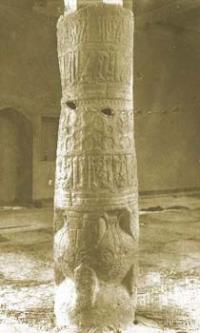Вы здесь
Ancient settlement Sairam.


The Great Silk Road and Sairam.
“For everything in this journey of life we are on, there is a right wing and a left wing: for the wing of love there is anger; for the wing of destiny there is fear; for the wing of pain there is healing; for the wing of hurt there is forgiveness; for the wing of pride there is humility; for the wing of giving there is taking; for the wing of tears there is joy; for the wing of rejection there is acceptance; for the wing of judgment there is grace; for the wing of honor there is shame; for the wing of letting go there is the wing of keeping. We can only fly with two wings and two wings can only stay in the air if there is a balance. Two beautiful wings is perfection. There is a generation of people who idealize perfection as the existence of only one of these wings every time. But I see that a bird with one wing is imperfect. An angel with one wing is imperfect. A butterfly with one wing is dead. So this generation of people strive to always cut off the other wing in the hopes of embodying their ideal of perfection, and in doing so, have created a crippled race”
C. JoyBell C.
Ancient fortifications on the Great Silk Road of Central Asia.
Ispijab (Sairam) is the largest, central city on the Great Silk Road. It was first mentioned in Xuan Jiang's route records of 629 as "a city on the White River." The ancient settlement of Sairam dates from the 1st - 19th centuries AD It is included as one of the priority historical and archaeological sites in the state program "Cultural Heritage".
Sairam has a huge abundance of holy graves. The hillfort located under the modern part of the city has a great threat of extinction, in view of the active urbanization and human activities on the components of the monument.
The preservation of the sites of the settlement is satisfactory, in places very poor, requiring the necessary measures to protect it and further preserve it. The outstanding universal value as the cultural value of the site of the fortress Sairam (Ispidzhab) is as follows:
The cultural and historical phenomenon of the Sairam settlement (Ispidzhab) is determined by its geographical location on the site of the Syr Darya transit corridor, which runs along the border of two global cultural, historical and natural zones: the nomadic zone of the Eurasian steppe belt and the zone of agricultural oases of Central Asia.
From Sairam (Ispidzhab) the caravan route went to Arsubaniket on Arys, to Otrar-Farab and further down the Syr Darya in the Aral Sea region. Trans-Eurasian communications of the Syr Darya corridor connected Margiana and Bactria, northern Iran, Western and Central Kazakhstan, the Urals.
The outstanding universal value of the Sairam settlement (Ispidzhab) lies in its material evidence of the exchange between the Steppe civilization and the civilizations of the Middle East, the exchange of values in material culture (topography of settlements, housing construction), religiously, in the field of technology (ceramics).
The following mazars still exist: the parents of the outstanding poet and religious mystic Yassavi Karashash ana (XVIII century), Ibrahim ata (XIII - XIX century), Abdel Aziz Baba (XV - XIX century) , Khoja Talig (XIII - XIX centuries), Mirali Baba (late XIX - XX centuries), Medieval minaret Khizr (XIII - XIX centuries) Ispidzhab (Sairam) - witness to the long and rich history of the famous trading the path connecting East and West - the Great Silk Road.
Ispidzhab was once a key trading point of the Silk Road in southern Kazakhstan. According to the Arab chronicler, there were markets in the city where traded fabrics, covered shopping arcades, and mosques. Despite the brisk trade, Ispidzhab, according to the ancient historian, left a pleasant impression of a clean and comfortable city. T
he historical relic of the city is the minaret of the Bazalak-ata mosque dating back to the XIIth century, two mausoleums associated with the name of Khoja Ahmed Yassavi, religious buildings built after the Dzungarian invasion.
Authority:
"Code of monuments of the South Kazakhstan region." Architectural and archaeological heritage of the South Kazakhstan region. In the framework of the regional program "Cultural Heritage". http://www.farsah.kz
Photos
Alexander Petrov.







